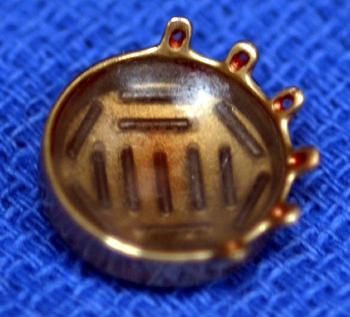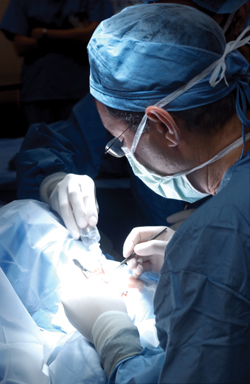
Plaque with radioactive beads. This device remained in Barbara Miller’s eye for one week, delivering radiation to her eye tumor.
VUMC offers brachytherapy to treat eye tumors

Dr. Paul Sternberg removed the plaque from Miller’s left eye.
A new Alabama resident, Barbara Miller, 67, went to the Department of Motor Vehicles this past July to get her state driver’s license. She was surprised when she failed her vision test because she had just gotten new glasses six months before. Miller went in for an eye exam and found the reason for her dramatic decrease of vision — she had a tumor in her left eye.
After going to a string of specialists, Miller was referred to Vanderbilt’s Dr. Paul Sternberg, G.W. Hale Professor and Chairman of Vitreo-Retinal Surgery and Diseases. She would become the second Vanderbilt patient to undergo radiation therapy to treat her ocular melanoma.
“They told me there was a procedure they could do to get rid of the tumor without removing my eye,” Miller said. “It’s amazing what they can do with technology these days.”
The procedure, brachytherapy, uses radioactive materials placed directly on or near a tumor to deliver radiation therapy. Vanderbilt doctors have used brachytherapy for other areas, such as the prostate, but until two months ago, had never used it to treat eye tumors.
Sternberg joined the faculty at Vanderbilt in January, bringing this procedure with him. With his expertise and the help of Charles W. Coffey, II, Ph.D., chief of Clinical Physics for the department of Radiation Oncology, and Dr. Ming Ting, radiation oncologist for the department of Radiation Oncology, Vanderbilt has performed three procedures and anticipates providing brachytherapy to one to two patients a month.
“The procedure is very successful,” Sternberg said. “Brachytherapy is a way to treat this condition without removing the eye, and without compromising mortality. Many times it allows patients to retain some amount of vision.”
Brachytherapy has been an alternative to removal of the eye since the mid 1980s; however, the efficacy of the procedure was relatively unknown until the late 1990s. According to the Cooperative Ocular Melanoma Study, brachytherapy and eye-removal have relatively the same five-year survival rate, approximately 81 percent.
Ocular melanoma is a relatively uncommon condition, with approximately 1,500 new cases in the United States each year, peaking in those in their sixties.
To be a candidate for this form of radiation, a patient’s tumor must be medium-sized, ranging from 2.5 to 10 millimeters in thickness and no more than 16 millimeters in diameter, and free of complications.
After Sternberg determined the dimensions of Miller’s tumor, he passed the information on to Coffey, who began the standard process of preparing the radioactive seeds for the procedure.
With the diameter and thickness of the tumor, Coffey used a computer program to determine the amount and strength of the radioactive seeds. He placed the seeds by hand into a plastic seed carrier that has grooves for them to settle in. Coffey glued this into a gold plaque, which can range in size from smaller than a dime to as large as a nickel, based on the size of the tumor. Miller’s plaque was about the size of a penny. After 24 hours, the radioactive plaque was sterilized and ready for use.
In a 45-minute procedure, Sternberg sewed the plaque onto the external wall of Miller’s eye, directly onto the tumor.
“The hardest part about this procedure is placing the plaque precisely on the tumor,” Sternberg said. “It must be accurate to be effective.”
After the procedure, the level of radiation Miller was releasing was measured and Miller was allowed to leave the hospital.
“The gold plaque is a high density material that protects the environment from the radiation,” Coffey explained. “But to take extra safety precaution, we cover the eye with a lead patch.”
The plaque stays in place for seven days, and it is relatively comfortable.
“I had no pain after the surgery,” Miller said. “Sometimes it would feel like I had an eyelash in my eye, but that was it.”
After having the plaque removed, Miller said she can see through her eye, but it’s a bit blurry. She won’t know for three months whether or not her treatment was effective. Only 5 percent of tumors continue to grow after this type of procedure. Right now she’s focusing on recovering.
“She’s a pretty good patient,” Miller’s husband, Bobby, said. “Of course she called me every name there is, but that’s because I make sure she takes her drops and her medications.”
If all goes well, Miller and her husband, who’s on the list for a heart transplant at Vanderbilt, hope to be back out fishing off of their pontoon boat when the weather warms up.













